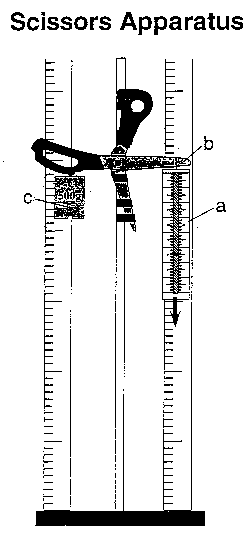Contributed by: Kentucky Department of Education (KDE)
PERFORMANCE TASK STUDENT RESPONSE FORM
| TASK: S1- "A Cut Above the Rest" |
|
GRADE 11 |
| Student Name: _______________________________________________
|
| School Name:________________________________________________ |
School Code: _________ |
GENERAL INSTRUCTIONS:
Write your name, school name and school code on the lines above.
You will have a total of 45 minutes to complete this task. You
may use up to 20 minutes to complete the group work. When your group
is finished with the group work, one member of the group should
tell the facilitator that you have finished. Then you may go on
to the individual work. You may not talk while you are working on
those pages.
Your group should have the following materials:
- 1 diagram showing scissors apparatus
- 1 calculator for each student
- 1 metric ruler (30 cm) for each student
- 1 scissors apparatus
- 1 spring scale (20 N capacity)
- 1 4.9 N weight (Note: a 500 g mass has a weight of 4.9 Newtons
on Earth)
- 1 ring stand
- 2 meter sticks
- duct tape
- pencils
GROUP ACTIVITY
The Law of Conservation of Energy implies that the work put into
a machine is equal to the work done by the machine. The work is
found in each case by multiplying the force times the distance.
Work is a measure of the energy transferred by a machine. The purpose
of this task is to analyze how the Law of Conservation of Energy
applies to the design and use of scissors. Your group will be determining
the output work for a standard pair of scissors.
You will be using the scissors apparatus to do ten trials to determine
the work output for the scissors. Refer to the diagram of the scissors
apparatus. You will use the 4.9 N weight as the input force for
this system. Hang the weight from the finger hole of the scissors
as shown in the diagram.
For the first trial, you will hang the spring scale at the 1 cm
mark on the scissors blade. For each successive trial, you will
hang the scale at the next centimeter marked on the blade. Each
time you move the scale to begin the next trial, make sure the horizontal
blade is level.
Use the spring scale to pull down on the horizontal blade of the
scissors (see diagram) at each centimeter mark along the blade,
determining the force required to move the 4.9 N mass up 2 cm
(.02 m) each time. You must work together as a team to accomplish
this task. The three steps listed below must be done simultaneously
for each trial. Assign one member of the group to perform each step.
| 1. |
a. |
Pull down with the spring scale and record the
vertical force (measured in Newtons) required to move the 4.9
N weight up 2 cm. (See diagram, location a.) |
| |
b. |
Measure and record the vertical distance the blade
moves down during each trial. (See diagram, location b.) |
| |
c. |
Watch the 4.9 N weight and notify the team when
it has moved up up 2 cm. (See diagram, location c.) |
- Repeat this procedure at each marked centimeter along the horizontal
blade of the scissors. The 4.9 N weight must be moved up a distance
of 2 cm during each trial.
- Record the data in the chart below. All group members must fill
in their own charts.
- After your team has completed all trials, use the data to calculate
the output work done at each location. The output work
is calculated by multiplying the vertical force on the spring
scale time the vertical distance that the blade moved [W=FxD].
| Horizontal distance from the center
of the scissors |
Vertical force measured with spring
scales (measured in Newtons) |
Vertical distance that the blade
moves down (in meters) |
Work output
Work = Vertical Force
x Vertical Distance
(W = F x D) |
| 1 cm |
|
|
|
| 2 cm |
|
|
|
| 3 cm |
|
|
|
| 4 cm |
|
|
|
| 5 cm |
|
|
|
| 6 cm |
|
|
|
| 7 cm |
|
|
|
| 8 cm |
|
|
|
| 9 cm |
|
|
|
| 10 cm |
|
|
|
When you are finished with the work on this page, one member of
the group should tell the facilitator that your group has finished
its group work. Then do the individual work. Remember that you must
work along on those pages. You may not discuss the questions or
share information.
INDIVIDUAL ACTIVITY
- Make a graph on the grid provided below, using some of the data
that you recorded in your data table on page 4. Graph the vertical
force vs. the horizontal distance.

- Interpret what the graph shows you about the cutting forces
of scissors.
____________________________________________________________________________
____________________________________________________________________________
____________________________________________________________________________
____________________________________________________________________________
____________________________________________________________________________
____________________________________________________________________________
____________________________________________________________________________
____________________________________________________________________________
- Compare the work output recorded in your data table with the
work put into the finger hole. The work input is 4.9 N x 0.02
m = 0.098 N-m. Do your results supports the Law of Conservation
of Energy? Explain your reasoning.
____________________________________________________________________________
____________________________________________________________________________
____________________________________________________________________________
____________________________________________________________________________
____________________________________________________________________________
____________________________________________________________________________
____________________________________________________________________________
____________________________________________________________________________
- Using all of the information you have collected, design a pair
of scissors that a small child could use to cut a piece of heavy
cardboard. Make a diagram, and describe the features of your scissors.
____________________________________________________________________________
____________________________________________________________________________
____________________________________________________________________________
____________________________________________________________________________
____________________________________________________________________________
____________________________________________________________________________
____________________________________________________________________________
____________________________________________________________________________

|



